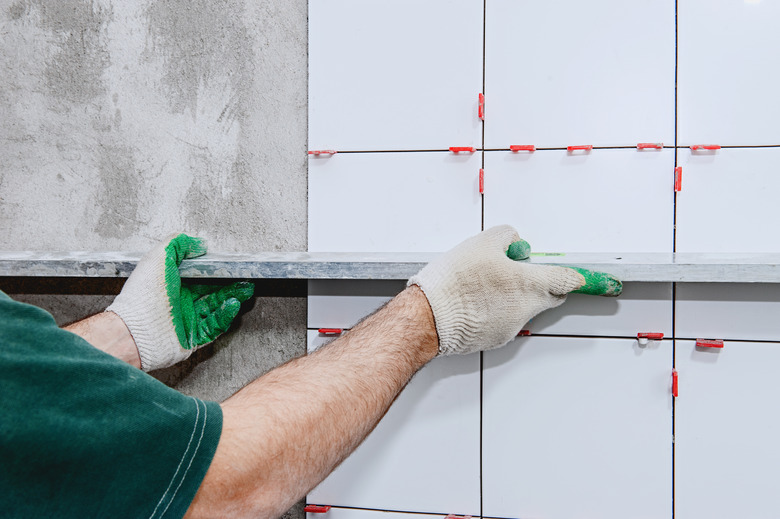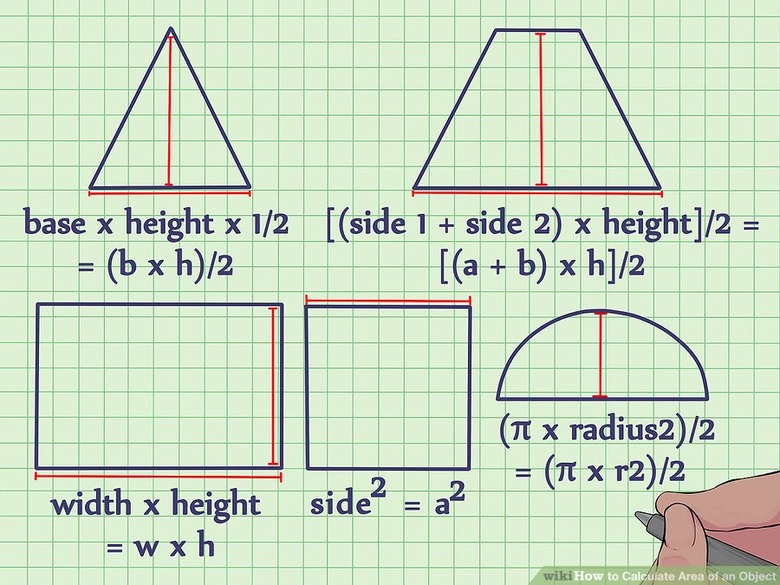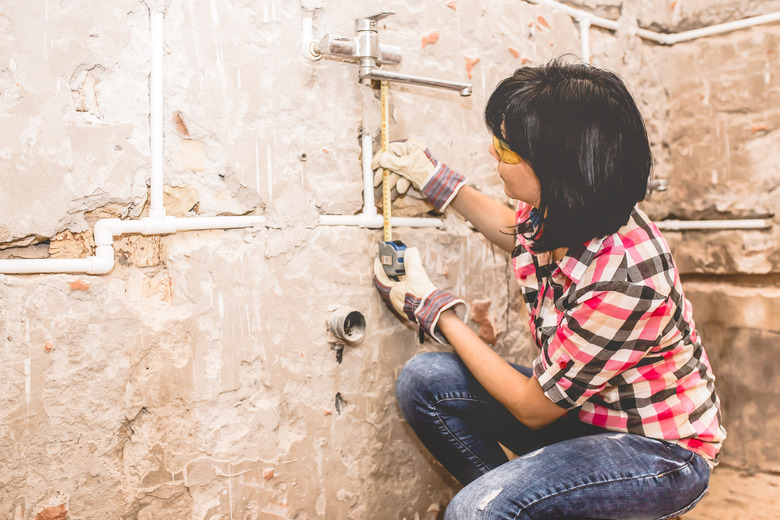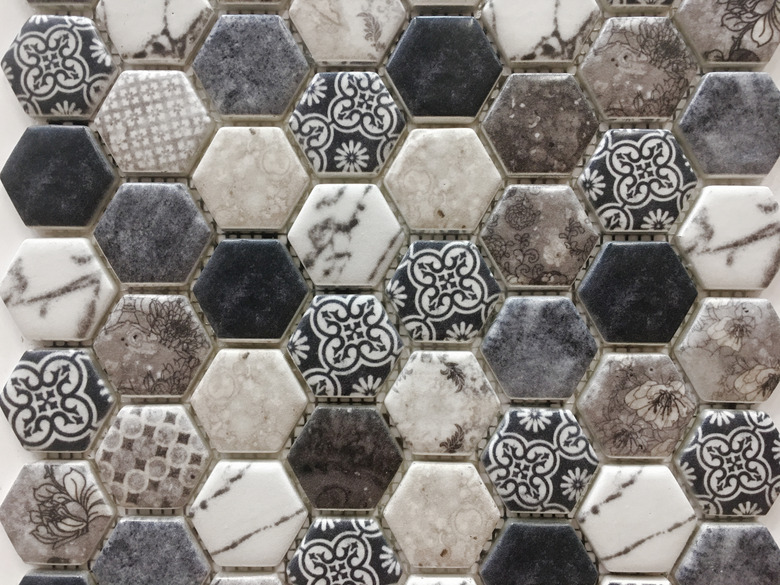How To Estimate Tile
Tile isn't free, so you don't want to buy more than you need for a project. On the other hand, you don't want to run out with the job halfway done, either. These are two good reasons for accurately estimating the amount of tile you need, but there's an even better one, especially if you're ordering the tile from a distant source. If you come up short on your estimate, you may discover that the extra tiles you order to complete the job come from a different batch and don't quite match the ones you have on hand. That's a problem you're better off not facing.
Accurately calculating the amount of tile you need begins with accurate measurements. It's a good idea to make these measurements more than once to double check them. The actual calculation is straightforward if the space to be tiled is rectangular. If it's triangular or has curved edges, though, measurement and calculation are more challenging, and so is fitting the tiles. It's important to work an overage into every tile estimate, whether the space is rectangular or not, but if the space is irregular, you'll want to increase the overage to ensure you have enough tile for the inevitable waste that comes when you cut or accidentally damage tiles.
Estimating Tile for a Rectangular Space
Estimating Tile for a Rectangular Space
Most walls and floors are rectangular, and calculating the area of a rectangle is easy. You need two measurements: the length (L) of the rectangle and the width (or height) (W). You get the area (A) of the rectangle by multiplying these together. The equation is A = L x W. To get the number of tiles you need (N), you divide the area by the area of a single tile (a):
N = A ÷ a.
Easy, right?
There's just one small catch, if you're working in the United States. You might measure the room dimensions in feet, but tile dimensions are often provided in inches. There are two ways around this. This first way is to convert the tile dimensions to feet. To do this, just divide the length and width of the tile by 12. A tile 6 inches x 6 inches is one that is .5 feet x .5 feet, for example. The second way is to go ahead and calculate the area of one tile in square inches and convert that to square feet. In this case, you divide the total area by 144, which is the number of square inches in a square foot. A 6-inch x 6-inch tile is 36 square inches, or .25 square feet.
Alternatively, you can measure the room dimensions in inches, calculate the relevant areas in square inches and divide by the area of a tile in square inches.
Example: Estimating Tile for Bathroom Walls
Example: Estimating Tile for Bathroom Walls
Suppose you want to install 4-inch tiles on your bathroom walls, floor to ceiling. You will calculate the entire wall area and divide that by the area of a single tile to get an estimate of the number of tiles—before adding an overage. Here's the procedure:
1. Measure the Ceiling Height and Floor Dimensions
Suppose the ceiling is a standard 8 feet (96 in.) from the floor and the floor dimensions are 10 ft, 6 in. (126 in.) by 12 ft, 3 in. (147 in.) If you measure in feet and inches, the calculations are easier to if you convert to decimal fractions: 10.5 feet by 12.4 feet.
2. Calculate the Total Wall Area
You've got two walls that have a length of 10.5 feet (126 inches.) and a height of 8 feet. (96 inches.). The area of each of these walls is 10.5 x 8 = 84 square feet or 12,096 square inches.
You have two more walls with length 12.4 feet (147 inches.) and height 8 feet. Each of these has an area of 12.4 x 8 = 99.2 square feet or 14,285 square inches.
Add the areas of the four walls to get a total wall area of 366.4 square feet or 52,762 square inches.
Tip
Don't forget to subtract the areas of doors, windows, areas occupied by cabinets and other areas that won't be tiled from the total wall area.
3. Calculate the Area of a Single Tile
If you measure wall area in square feet, you need to convert the length of each side of a tile to feet by dividing the measurement in inches by 12. Thus, each tile has a length of 4 inches ÷ 12 in = 0.33 feet, and its area is 0.33 feet x 0.33 feet = 0.11 square feet. Alternatively, you can calculate the area in square inches, which is 4 inches x 4 inches = 16 square inches, and divide this by 144 square inches, to get 0.11 square feet, which is the same result.
If you calculate wall area in square inches, you don't need to convert tile area. Just multiply the length of one side— measured in inches— by the other side to get the area in square inches (144).
Tip
Do you want to install hexagonal tiles? The area of a hexagon with sides of length L is given by this formula: A = (3√3 x L2/2) = 2.6 x L2.
4. Divide Wall Area by Tile Area to Get Number of Tiles
In our example, the wall area is 366.4 square feet (52,416 square inches), and the area of a single tile is 0.11 square feet (16 square inches.). Divide the tile area into the wall area to find you need 366.4 ÷ 0.11 (52,762/16) = 3,331 tiles.
Tip
Tiles—especially floor tiles—often come in boxes, and each box may have a label that specifies the coverage area of that box. In that case, divide the total area to be covered by the coverage of a single box to find how many boxes you need.
Refine Your Tile Estimate and Add an Overage
Refine Your Tile Estimate and Add an Overage
A rough estimate doesn't take into account the gap between tiles, which is filled with grout. This gap is negligible when estimating tiles larger than 4 inches, but it can be significant for very small tiles. You might not have to worry about it, because small tiles usually come stuck to mesh squares, and the container usually specifies the coverage of a square. If you're installing 1- or 2-inch tiles by hand, though, you might have to add the width of the grout joint to the length and width of the tile when calculating the area of a single tile.
Another factor that a rough estimate doesn't take into account is wastage for cutting and fitting. The rule of thumb for most tile installations is to add a 10 percent overage to the final estimate to account for waste. In the example above, add 333 tiles to the rough estimate to get 3, 664 tiles—a more realistic number.
Finally, don't forget border and bullnose tiles, if you plan on using them. Measure the lengths of all the borders for which you need tiles and divide by the width of one tile to determine the number of border tiles you need.
Estimating Tile for Irregular Spaces
Estimating Tile for Irregular Spaces
Not all walls, floors and countertops are rectangular. Some are triangular, and some have curved edges. The best way to calculate the area of an irregular space is to make a scale drawing of the space on graph paper, letting each subdivision stand for a foot. If you graph on plain paper, a suitable scale would be one centimeter per foot. Divide the drawing as closely as possible into smaller rectangles, then calculate the area of each rectangle and add up the areas. Consider increasing the overage allowance to 15 or 20 percent to allow for the approximation inherent in this method calculations, as well as the extra cutting that will be required to fit tiles into the irregular space.




